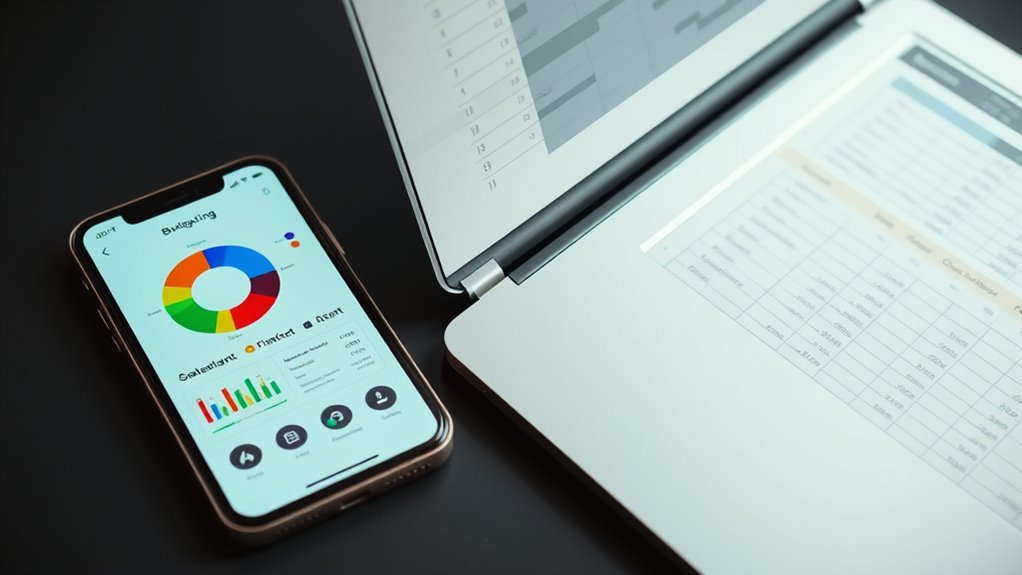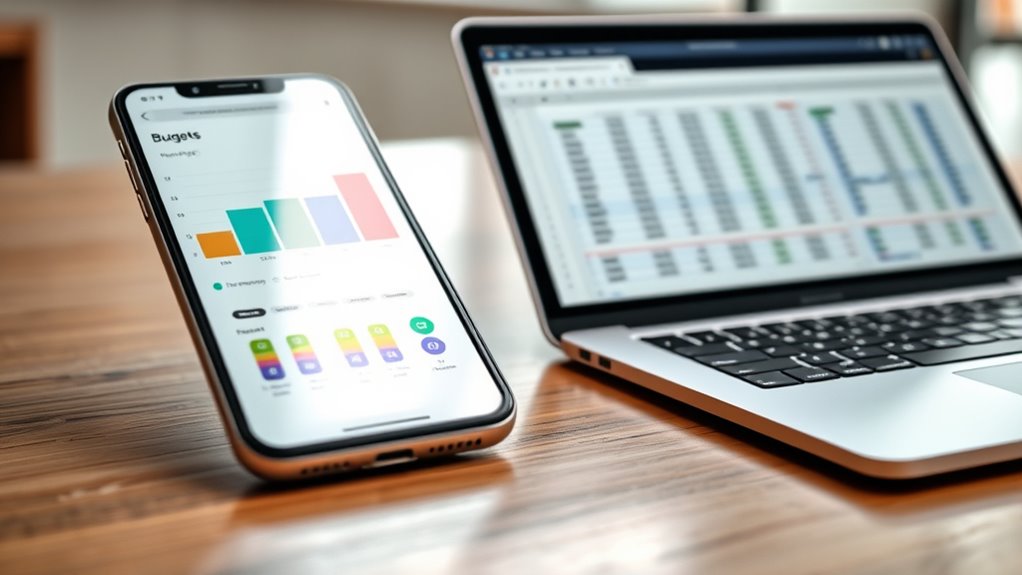Choosing between budgeting apps and spreadsheets depends on your needs. If you want automation, real-time updates, and a seamless mobile experience, apps are a great fit. But if you prefer full customization, complex formulas, and control over every detail, spreadsheets offer unmatched flexibility. Both have security considerations and costs to weigh. To find out which aligns best with your style, explore the key differences and benefits further.
Key Takeaways
- Spreadsheets offer unmatched customization for complex, personalized budgeting, while apps prioritize automation and ease of use.
- Budgeting apps provide real-time updates and automatic transaction syncing, reducing manual effort.
- Spreadsheets are cost-effective, accessible across devices, and allow detailed visualizations tailored to user needs.
- Apps often have more secure data protections, but involve subscriptions; spreadsheets depend on user security practices.
- The best choice depends on user preference for control and customization versus convenience and automation.

When choosing between budgeting apps and spreadsheets, understanding their strengths and limitations can help you find the best fit for your financial management style. Spreadsheets offer unmatched flexibility, letting you define categories, layouts, and formulas precisely to your needs. You can create custom systems like cash flow forecasts or sinking funds without restrictions on design. This freedom means you can tailor your budget to fit complex or unique financial situations. Plus, manually entering data encourages you to stay engaged with your finances and reflect on your spending habits. You control every aspect, making spreadsheets ideal if you prefer a highly personalized approach.
Spreadsheets offer unmatched flexibility for personalized, complex, and unique financial management.
On the other hand, budgeting apps prioritize automation and convenience. They sync transactions automatically, reducing manual data entry and providing real-time updates. This setup makes tracking your expenses quick and seamless, especially if you’re busy or want quick insights into your financial health. Many apps also offer auto-import features, keeping your budget current without much effort from you. While automation boosts efficiency, it can sometimes mislabel transactions or introduce errors, which you’ll need to catch and correct. App workflows tend to be rigid, making it harder to adapt to unusual circumstances like irregular income or joint accounts, but they’re generally faster to set up and easier to use, especially for those seeking straightforward solutions.
Cost is another factor. Most budgeting apps operate on a subscription basis, with fees for advanced features, though free options exist—albeit with limited reporting or goal-tracking capabilities. Spreadsheets like Excel or Google Sheets can be accessed for free or via a one-time purchase, and they’re accessible across multiple devices through cloud platforms. This accessibility makes spreadsheets portable and convenient, especially if you prefer working across different devices or want to avoid recurring costs. Both tools support mobile access, but apps usually provide a more seamless mobile experience, allowing you to check your budget on the go effortlessly.
Data visualization and reporting differ between the two. Spreadsheets let you create fully customizable charts, progress bars, and summary tables that match your preferences. Many budgeting apps include built-in visualizations, but these may not always offer the clarity or flexibility you desire. Premium app features often include detailed spending reports and goal progress tracking, but users tend to report higher satisfaction with how data is displayed in spreadsheets, citing app inflexibility as a common frustration. Collaboration is easier in cloud-based tools like Google Sheets, which support real-time multi-user editing, making team budgeting more practical. Additionally, the ability to easily share and collaborate on spreadsheets can be a significant advantage for joint financial planning.
Security and privacy depend on your practices and the tools you choose. Dedicated budgeting apps invest in encryption, two-factor authentication, and secure backups, aiming to protect your data. Spreadsheets rely on your security habits—cloud services benefit from provider protections, while local files depend on manual safeguards. Both methods carry risks if sensitive data is compromised, but apps might gather more information in one place, increasing the potential impact if breached. Ultimately, your choice hinges on balancing convenience, control, cost, and security. [Understanding these differences can help you make an informed decision aligned with your personal privacy preferences.
Frequently Asked Questions
Can Spreadsheets Automate Financial Alerts Like Apps Do?
Spreadsheets can’t automate financial alerts as easily as apps do. While you can set up formulas and conditional formatting to flag certain thresholds, it requires manual effort and technical know-how. Apps, on the other hand, automatically send notifications when bills are due, balances are low, or spending limits are reached. If you want real-time alerts with minimal setup, apps are the better choice for automation and convenience.
Are Budgeting Apps More Secure Than Spreadsheets?
Budgeting apps are generally more secure than spreadsheets, with around 80% of users trusting apps for their financial data. They use encryption and multi-factor authentication to protect your information. Spreadsheets, especially when stored locally, lack these protections and are more vulnerable to hacking or accidental sharing. So, if security matters most, opting for a reputable budgeting app offers better peace of mind and safer data management.
Which Method Is Better for Collaborative Budgeting?
You’ll find budgeting apps are better for collaborative budgeting because they allow real-time updates and seamless sharing with multiple users. You can easily assign tasks, leave comments, and track changes instantly. Spreadsheets can also work, but they often require manual sharing and version control, which can cause confusion. Apps streamline teamwork, making it simpler to stay on the same page and manage budgets together efficiently.
Do Spreadsheets Support Real-Time Expense Tracking?
Yes, spreadsheets support real-time expense tracking. You can input expenses instantly, update figures, and see changes immediately. With shared spreadsheets, your team can collaborate seamlessly, making sure everyone stays up-to-date. You get instant updates, accurate records, and better control over your budget. This dynamic process helps you monitor spending, identify issues early, and make informed decisions—all in real time.
Can Budgeting Apps Integrate With All Bank Accounts?
Most budgeting apps can’t integrate with all bank accounts due to differing banking systems and security protocols. However, many popular apps support a wide range of banks and financial institutions, making it easier for you to sync your accounts. You should check the app’s supported banks before committing, but generally, apps offer extensive integrations that cover most major banks, simplifying your financial management process.
Conclusion
So, whether you prefer the sleek convenience of budgeting apps or the nostalgic charm of spreadsheets, remember that both tools aim to keep your finances in check. Ironically, the choice might come down to which method you trust less—technology or your own messy formulas. In the end, it’s not about the tool, but about staying committed. After all, even the best app or spreadsheet can’t save you from financial chaos if you ignore the details.









